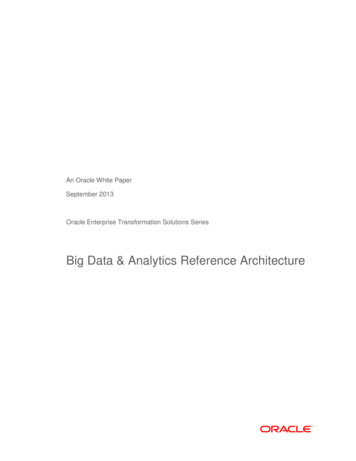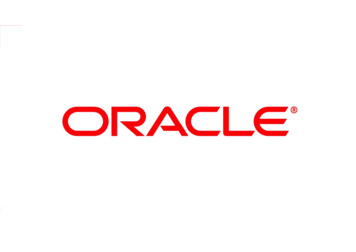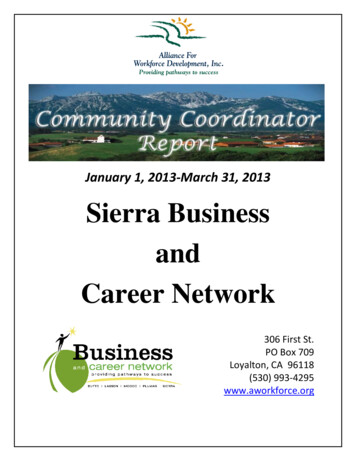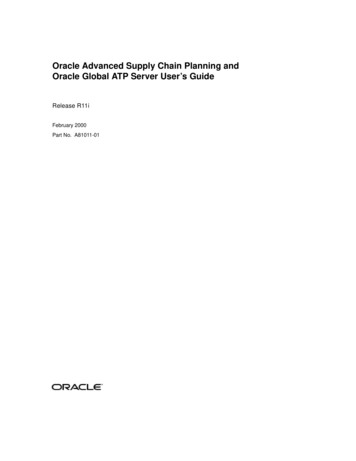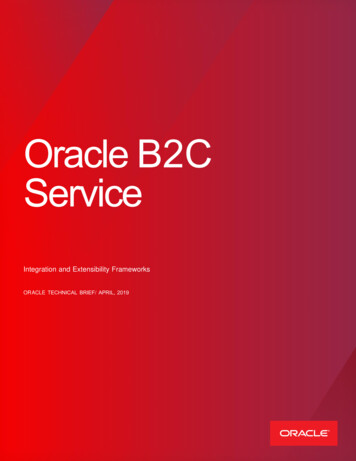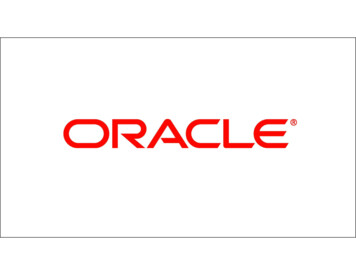
Transcription
1Copyright 2013, Oracle and/or its affiliates. All rights reserved.
Getting Optimal Performancefrom Oracle E-Business SuiteSamer BarakatDevelopment Director, Applications Performance2Copyright 2013, Oracle and/or its affiliates. All rights reserved.
The following is intended to outline our generalproduct direction. It is intended for informationpurposes only, and may not be incorporated into anycontract. It is not a commitment to deliver anymaterial, code, or functionality, and should not berelied upon in making purchasing decisions. Thedevelopment, release, and timing of any features orfunctionality described for Oracle's products remainsat the sole discretion of Oracle.33Copyright 2012, Oracle and/or its affiliates. All rightsCopyright 2013, Oracle and/or its affiliates. All rights reserved.reserved.
Program Agenda Performance Triage & Resolution Optimizing E-Business Suite Applications Tier Optimizing E-Business Suite Database Tier Optimizing E-Business Suite on RAC E-Business Suite on Engineered Systems Optimizing E-Business Data Management Optimizing E-Business Platform Migration Q&A4Copyright 2013, Oracle and/or its affiliates. All rights reserved.
Performance Triage & Resolution5Copyright 2013, Oracle and/or its affiliates. All rights reserved.
Performance Triage & ResolutionHow to Approach a Performance Issue DEFINE the problem clearly GATHER the right data to analyze the issue Identify the ROOT CAUSE of the problem, possibly gather additional data Search for a KNOWN SOLUTION or workaround that addresses the root cause ofthe problem If it is a product issue, PASS ON the right information to support/dev through theregular channels Try to identify a TEMPORARY WORKAROUND to alleviate the issue while you get apermanent fix6Copyright 2013, Oracle and/or its affiliates. All rights reserved.
Performance Triage & ResolutionDefine the Problem Get a clear understanding & quantitative definition of the issue Where is the time going ? Get the right diagnostics– What?– Where?– When?– Why?– How? Identify the Techstackcomponents in-play Refer to the architecture7Copyright 2013, Oracle and/or its affiliates. All rights reserved.
Performance Triage & ResolutionDefine the Problem 80% of issues are DB processing related If non-database (client side) processing occurs within the flow, you may see DBwait events likeSQL*Net Message from clientTCP Socket%PLSQL Lock Timer Keep a watchful eye on OS metrics and resource consumption in all 3 tiers8Copyright 2013, Oracle and/or its affiliates. All rights reserved.
Performance Triage & ResolutionGather Diagnostic DataStart with MOS ID 1121043.1 for How-to & Best Practices SQL Tuning Trace files SQLT output (MOS ID: 215187.1) Trace Analyzer (MOS ID: 224270.1) AWR Report (MOS ID: 748642.1) 11g SQL Monitor Report AWR SQL Report (awrsqrpt.sql) PL/SQL Tuning Product logs PL/SQL Profiler (MOS ID: 808005.1) Reports Tracing (MOS ID: 111311.1)9Copyright 2013, Oracle and/or its affiliates. All rights reserved. Database Tuning AWR Report (MOS ID: 748642.1) ADDM report (MOS ID: 250655.1) Active Session History (ASH) Forms Tuning Forms Tracing (MOS ID: 373548.1) FRD Log (MOS ID: 445166.1) Generic note (MOS ID: 438652.1) Middle tier Tuning JVM Logs JVM Sizing/Tuning (MOS ID:362851.1,278868.1) OS - OSWatcher (MOS ID: 301137.1)
Performance Triage & ResolutionGather Enhanced Performance Diagnostics for Oracle E-Business Suite(MOS ID: 1362660.1) Gather as much diagnostic data as possible in one round trip to customer. Available on 12.1.3 as a standalone patch# 12544073 (Mandatory Pre-Requisite ADPatch# 12991557) Enhancement to FND TRACE : New procedure “set preferences” enables you to– Enable tracing for sessions– Enable tracing for one or more SQL statements using SQL ID (*)– Generate CBO trace when tracing SQL statements (*)– Trace PL/SQL using PL/SQL Hierarchical Profiler (*)– Set Statistics Level (*) - Only in Oracle Database 11g 10Copyright 2013, Oracle and/or its affiliates. All rights reserved.
Performance Triage & ResolutionGather Enhanced Performance Diagnostics for Oracle E-Business Suite(MOS ID: 1362660.1) One or more of the following outputs can generated automatically after the end of tracedsession. The concurrent program 'Gather Diagnostic Data for Traced Sessions' isautomatically submitted via 'System Administrator responsibility to gather this output.– AWR, ADDM and ASH Reports– Session Statistics– SQLT output (*)– Trace Analyzer output, which includes SQLT output for top SQLs– Objects statistics when a SQL statement is traced, but SQLT output is not chosen or not installed– Real-Time SQL Monitor Report when a SQL statement is traced (**)– SQL Detail Report when a SQL Statement is traced (***) (* )Requires SQLT tool - Note 215187.1,11.2.0.1 11Copyright 2013, Oracle and/or its affiliates. All rights reserved.(** )Oracle DB 11g (*** )Oracle DB
Performance Triage & ResolutionGather Diagnostic Data Establish baselines for different workloads by collecting system level performanceinformation–––– AWR (Automatic Workload Repository) ReportADDM (Automatic Database Diagnostic Monitor) ReportASH (Active Session History) ReportReal-Time SQL Monitoring Report (11g ) (Parallel queries and queries taking 5 seconds)Operating system statistics– OSW Document Doc ID 301137.1– OSWg Document Doc ID 461053.112Copyright 2013, Oracle and/or its affiliates. All rights reserved.
Performance Triage & ResolutionGather Diagnostic Data Monitor and trace critical flows & concurrent programs– ASH (Active Session History) Report– SQL Trace Level 8 (with waits) or Level 12 (with waits and binds) followed by TKPROF Check both raw trace and TKPROF Interpreting Raw SQL TRACE files MOS Doc ID 39817.1– Trace Analyzer (TRCA) reads an Event 10046 SQL Trace file and provides acomprehensive report for performance analysis and tuning MOS Doc ID 224270.1 Monitor and trace specific SQLs– SQLTXPLAIN (aka SQLT) MOS Doc ID 215187.1 Maintained by Oracle Support - often requested Collects information on why the execution plan was chosen13Copyright 2013, Oracle and/or its affiliates. All rights reserved.
Performance Triage & ResolutionGather Diagnostic DataTrace/TKPROF ? Get the complete session storySet Trace Parameters– max dump file size unlimited Ensure there is sufficient disk space in the tracing directory– user dump dest or if diagnostic dest is set in Oracle11g (diagnostic dest)/diag/rdbms/(dbname)/(instname)/trace background dump dest for parallel slave processes– STATISTICS LEVEL ALLGenerate Trace– Forms: Help - Diagnostics - Trace– OA HTML: Diagnostics - Tracing– Set the profile: “Initialization SQL Statement - Custom“. Use FND CTL.FND SESS CTL14Copyright 2013, Oracle and/or its affiliates. All rights reserved.
Performance Triage & ResolutionGather Diagnostic DataTrace/TKPROF ? Get the complete session storyRaw trace must be– From before the user action began To the point the DB session ends**– A complete, non-truncated trace file*** DUMP FILE SIZE IS LIMITED TO 12345 BYTES***Run TKPROF from the correct Oracle home Use the sort options fchela,exeela,prselaTKPROF output MUST have Runtime Execution Plans and Row Counts & Row Source Stats Run Time Execution Plan “Row Source Operation” ! “Explain Plan”Best practices, detailed how-to steps & recommended tracing patches MOS Doc 1121043.1 (Also review Appendix B – Getting In-Memory partial runtimestats)15Copyright 2013, Oracle and/or its affiliates. All rights reserved.
Performance Triage & ResolutionGather Diagnostic DataAutomatic Workload Repository (AWR) ? Get the complete system story– Regularly Review Automatic Workload Repository (AWR) data for different workloads– Use DBMS WORKLOAD REPOSITORY or Enterprise Manager to create snapshots– Generate reports using ORACLE HOME/rdbms/admin/awrrpt.sql– Review the Advisory sections in AWR to fine tune SGA & PGA.– Monitor and correlate top SQL in AWR to business flows.– Review Load Profile and Top 5 Timed Events section to determine utilization & bottlenecksand review relevant detailed sections for these events.16Copyright 2013, Oracle and/or its affiliates. All rights reserved.
Performance Triage & ResolutionAnalyze Root Cause Regularly Review Automatic Workload Repository (AWR) data for different workloads– For Latch related waits Often due to: non-sharable SQL, sub-optimal SQL which performs full table or fullindex scans, dynamic object creation/removal, etc. Review the latch Statistics section to determine the hot latches Trace waiter and holder sessions to determine actual cause– For I/O related waits Review SQL sections by Logical/Physical reads and the Segment Statisticssections by I/O– For Enqueue related or buffer busy waits Review the following sections: enqueue, segment statistics by buffer busy waits,row lock & ITL waits17Copyright 2013, Oracle and/or its affiliates. All rights reserved.
Performance Triage & ResolutionAnalyze Root Cause If bottleneck is IO related.(db file sequential read, db file scattered read, log file sync, free buffer waits, etc.)– Tune Top SQL is always the first step– Make sure that system has updated statistics.– Maximize Memory availability, allocate generously to buffer cache, review AWRadvisories & monitor swapping & paging.– Use ASM or alternatively use the SAME methodology for db files.– IO Sub-system: RAID 10 still preferred most often for high end requirements Ideal avg. responsetimes of 10ms.– Check for excessive/redundant indexing.– Configure async IO, use quick IO technologies.18Copyright 2013, Oracle and/or its affiliates. All rights reserved.
Performance Triage & ResolutionAnalyze Root Cause If the bottleneck is concurrency related(enq%, latch%, buffer busy%, etc )– Use global hash-partitioned indexes for hot leaf blocks - Identify via AWR "Top logical––––––19IOs by Segment"Some of these waits are commonly caused by bad SQL execution plansi.e. :latch: cache buffer chains, %buffer busy waits, read by other sessionMake sure to use ASSM and OATM tablespace model.Increase INITRANS to alleviate ITL contention.Increase sequence caches,Work with support/consulting to evaluate if table/index partitioning will help .If the program allows, more frequent commits (batch size) can help by reducing theCR (consistent read) work required.Copyright 2013, Oracle and/or its affiliates. All rights reserved.
Optimizing E-Business SuiteApplications Tier20Copyright 2013, Oracle and/or its affiliates. All rights reserved.
Optimizing E-Business Suite Applications TierStay Current Apply latest Release Update Packs Release 12.1.3: Patch 9239090 : MOS ID: 1080973.1 Release 12.0 - RUP6: Patch 6728000 : MOS ID: 743368.1 Apply the latest EBS Family Packs Recommended Patch List “Recommended Performance Patches for the Oracle E-Business Suite”,MOS ID 244040.1 Recommended performance patches for all the modules and tech stackcomponents are consolidated in this note Upgrade techstack components to the latest certified certifications.html21Copyright 2013, Oracle and/or its affiliates. All rights reserved.
Optimizing E-Business Suite Applications TierUse Optimal Logging Settings FND: Debug Log Enabled - Set it to ‘Yes’ (12.0 RUP3 , 12.1.x) FND: Debug Log Level - Set to Unexpected (Level 6) Query FND LOG MESSAGES to check the logging traffic With above profile configuration If the query shows a large number of rows being created, there could beexceptions and errors which need to be investigated22Copyright 2013, Oracle and/or its affiliates. All rights reserved.
Optimizing E-Business Suite Applications TierOptimize Workflow Processes Purge runtime data (Conc Program: FNDWFPR) Can run by ITEM TYPE Monitor/Troubleshoot old workflows not properly closed Purge frequently For background engines via Concurrent Manager, set the ‘Process Stuck’parameter to ‘No’ Identification of stuck workflows is resource intensive Start a separate background engine to handle stuck/timed out processeswith a low frequency –i.e. once a day Use deferred activities to improve online response times for flows such asScheduling, PO Document Approval, etc.23Copyright 2013, Oracle and/or its affiliates. All rights reserved.
Optimizing E-Business Suite Applications TierOptimize Workflow Processes Run FND TOP/sql/wffngen.sql to translate the activity function calls into static calls Edit & add heavily used ITEM TYPES itemtypeList t (‘WFSTD’,’FNDFFWF’) Generates wffncal2b.pls in utl file dir to re-create pkg Disable retention on Workflow QueuesDBMS AQADM.ALTER QUEUE(queue name :b1,retention time 0); Partition runtime tables for higher scalability – MOS ID: 260884.1 For high volume batch processing in RAC use ITEM TYPE to Node affinityDefine node affinity at the program level ( See MOS Doc ID 1129203.1)24Copyright 2013, Oracle and/or its affiliates. All rights reserved.
Optimizing E-Business Suite Applications TierOptimize Forms Processes To reduce load on the database server, ensure users are optimally utilizing theprofessional Forms interfaces.– Avoid Blind queries– Provide selective criteria in Find windows and LOVs Minimize network traffic and form open times– Avoid opening and closing forms across transactions– Combine forms from multiple-products onto a single menu Generate complete SQL trace and Forms Runtime Diagnostics (FRD) to debugperformance issues25Copyright 2013, Oracle and/or its affiliates. All rights reserved.
Optimizing E-Business Suite Applications TierOptimize JVM Processes Total available memory is the most important factor affecting GC performance. Review the frequency of collections, especially major collections (i.e. Full GC) Enable verbose GC to tune heap sizes based on the GC traffic Start with: -Xms1024M and –Xmx1024M Setting -Xms and -Xmx to the same value avoids the need for heap memoryre-allocation during runtime26Copyright 2013, Oracle and/or its affiliates. All rights reserved.
Optimizing E-Business Suite Applications TierOptimize JVM Processes If full GCs are too frequent, consider increasing Xms and Xmx Consider using jstat to see and review each of the heap generations forpossible tuning Increase the number of JVMs to scale up for more users with faster GC times.– Each JVM has a smaller Xmx,Xms memory footprint so full GCs will befaster!27Copyright 2013, Oracle and/or its affiliates. All rights reserved.
Optimizing E-Business Suite Applications TierSize The Middle Tier For Concurrency The main contributors to the middle tier memory are the JVMs heaps, forms (frmweb)process memory and concurrent manager components, especially java concurrentprograms. To calculate physical memory for oacore JVM heap, the following formula can be used:M (N/ 150 ) * 1 GBWhere M total memory used by oacore VMsN total number of concurrent Self-Service users28 Use one JVM per 2 CPUs 100-150 concurrent users per JVMCopyright 2013, Oracle and/or its affiliates. All rights reserved.
Optimizing E-Business Suite Applications TierSize The Middle Tier For Concurrency To calculate physical memory for Forms frmweb processes, the following formula canbe uses used:M N * 40MBWhereM total memory used by Forms frmweb processesN total number of concurrent Forms users 29Care should be taken to size for the concurrent manager components, especiallyjava concurrent programs.Copyright 2013, Oracle and/or its affiliates. All rights reserved.
Optimizing E-Business Suite Applications TierSize The Middle Tier For Concurrency A new updated set of sizing guidelines for 12.2 has been published based internalbenchmarks with different workloads and concurrency levels, the information is availablethroughOracle E-Business Suite Installation Guide: Using Rapid InstallRelease 12.2 (12.2.0)Part Number E22950-16 30http://docs.oracle.com/cd/E26401 t 2013, Oracle and/or its affiliates. All rights reserved.
Optimizing E-Business Suite Applications TierOptimize the Concurrent Manager Manage CM Jobs Lifecycle: 50% of performance tuning is in the business!– Review long-running auto resubmitted jobs– Review short/long-running jobs – selective parameters?– Don’t purge jobs that the users then have to run again– Trim the fat: Review and eliminate concurrent jobs that are not required and/or are notbeing used by users. Manage CM Managers : More managers/workers ! more throughput– Avoid enabling an excessive number of standard or specialized managers.– A common guideline is between 1-2 target process per CPU, but this needs to bebalanced with resources required by online activity– Utilize Parallel Concurrent Processing (PCP) to leverage the Cluster (RAC)31Copyright 2013, Oracle and/or its affiliates. All rights reserved.
Optimizing E-Business Suite Applications TierOptimize the Concurrent Manager Manage CM State Data:– Purge the FND tables on a regular basis using the “Purge Concurrent Request andManager Data” program– Patch 7530490 for R12 or 7834670 for 11i (MOS ID 822368.1)– High throughput: Keep *.out and *.log on fast disks. Use Separate disks if throughputseems slow especially on NFS Filers– Truncate the reports.log file in log directory. Watch for 2GB limit on any output files(Doc ID 842850.1) Manage CM Schedules:– Use specialization rules and work shifts to bind specific jobs to specific time windows .– Avoid scheduling resource intensive batch requests during peak activity.– Reschedule some programs to run when the concurrent managers have excess capacity.– Define Workload Management Strategy based on job average duration and system usageprofile.32Copyright 2013, Oracle and/or its affiliates. All rights reserved.
Optimizing E-Business Suite Applications TierOptimize the Concurrent Manager: Workload Management Strategy–Avoid Short Sleep Times *Enough for a couple of minutes of work **Set cache size to at least twice the number of workers–33Specialization rules and work shifts Bind specific jobs to specific time windows Profile Option: Concurrent: Active Request Limit can be used restrict the numberof concurrent requests that may be run simultaneously by each user Specialize if there are too many jobs in a specific categoryCopyright 2013, Oracle and/or its affiliates. All rights reserved.
Optimizing E-Business Suite Applications TierOptimize the Concurrent Manager Conflict Resolution Manager Sleep Time:– To maximize throughput for jobs which spawn parallel workers (i.e. Auto Invoice, Payroll),consider reducing the sleep time of the Conflict Resolution Manager (CRM).– Default is 60s, consider 5 or 10 seconds Concurrent Manager Sleep Time:– Define dedicated queues for short and frequent requests and increase the sleep times formanagers which do not require near real-time job execution– Reducing sleep time to a very low value many cause excessive CPU utilization. Transaction Manager Sleep Time:– Set the profile “Concurrent:Wait for Available TM” to 1 (second) to minimize TM latency. Theprofile sets the total time to wait for a TM before switchover to next available TM– Set Sleep time on Transaction Managers to 30 minutes. this avoids constant polls to checkfor shutdown requests.34Copyright 2013, Oracle and/or its affiliates. All rights reserved.
Optimizing E-Business Suite Applications TierOptimize the Concurrent Manager 35CM Queues :–Consider dedicating certain concurrent managers to process either short or long runningprograms to avoid queue backup–Add more queues if all queues are running at maximum capacity only if resources permit.–Tune the sleep time for queues with a large number of target processes.Cache Size:–The cache size specifies the number of requests that will be cached each time theconcurrent manager reads from
Trace Analyzer (MOS ID: 224270.1) AWR Report . Automatic Workload Repository (AWR) Get the comple te system story – Regularly Review Automatic Workload Repository (AWR) data for different workloads – Use DBMS_WORK
